Advertisement
Published: March 20th 2017
64 out of 73 mushers finished the race. The last musher to arrive was Cindy Abbott. She got the Red Lantern Award. The significance of this is that they don't extinguish the lamp until the last musher comes into Nome. I put her musher profile up several days ago. Cindy Abbott has Wegener’s granulomatosis. I can't imagine doing a race like this and managing your illness. She also summitted Mt. Everest after she was diagnosed with the disease! Incredible!
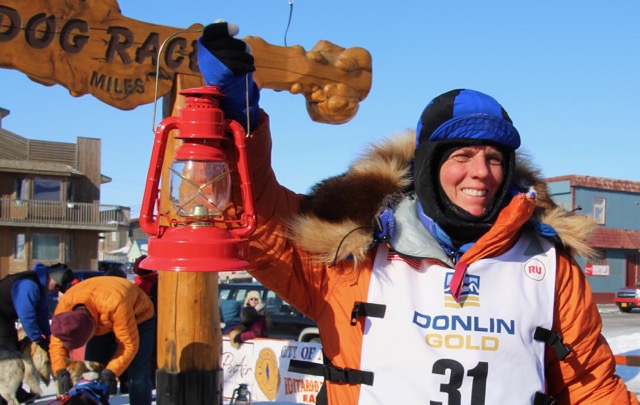
Cindy Abbott
Red Lantern Award
Cindy Abbott – 12 days, 2 hours, 57 minutes and 31
New record by 1 day, 1 hour and 45 minutes
Dropped Dogs Photos: Now I can put up pictures of the dropped dogs.I couldn't do it while the race was going. These dogs are flown back to Anchorage from the trail, checked by the veterinarians, and are either picked up by the musher's handlers, or taken to the prison where the inmates take care of them. The race is all about taking care of the dogs, and dropping a dog from the race is humane treatment of the dog.
Today I want to highlight the
Iditarod Air Force. Here's an article from the website.
Iditarod Air Force: lifeblood of the race
Posted by
Dorothy Olmstead in
Iditarod Date: March 19, 2017 11:00 pm
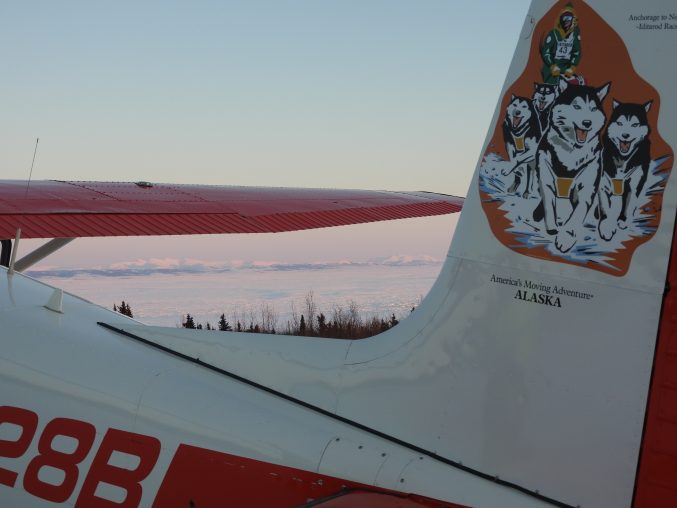
John Norris’s plane parked above the sea ice in Koyuk
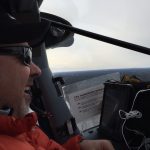
Matt Tomter enjoys flying to Galena
Forget Alaska-based aviation reality television shows––the Iditarod Air Force pilots are the real deal. With twenty-eight pilots comprising 300,000-plus cumulative flight hours––over 200,000 of which are in Alaska––there is no better group of pilots to call upon to grapple the logistical soup that is Iditarod. These volunteer pilots fly straw bales, drop bags, checkpoint volunteers, the Teacher on the Trail, the Insider crew, dropped dogs, checkpoint food, enough Tang to fill a space shuttle, and any other details that need to be addressed as the race is in motion. The required organization is mind-boggling, but with the help of a handful of volunteer flight coordinators, these pilots tackle their job with confidence and pride.
Multiple times on the trail I heard former competitive mushers say, “We never thought about all this when we were racing. We just came into the checkpoints and had no clue all this was going

 Dropped dogs behind Lakefront Hotel
Dropped dogs behind Lakefront Hotel
Note tag, this dog belongs to musher Bib # 70, and this is dog M.on in the background.” The details they weren’t noticing, were the infinite pieces that must come together to make the race run smoothly.
“It’s like fighting a war,” volunteer pilot, Wes Erb, says. “It’s a huge logistical effort. Your enemy is time and pressure. You have all these resources and they need to be there at a certain time. I think the backstory behind the race is almost as interesting, if not as interesting, as the race itself.”
These pilots volunteer not just their time, but also their single-engine airplanes to the race. “It’s rare in aviation to get a large group of people together that aren’t doing it for money,” Cessna 180 pilot Matt Tomter says. “But we get out here and we’re all on the same beat of music.”
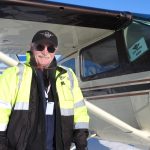
Jerry Wortley beside his Cessna 206
Jerry Wortley, a tenth year Iditarod Air Force (IAF) pilot takes his role one step further. An aviation insurance broker in Idaho, Jerry typically flies his Cessna 180 up from Idaho in November or December each year to get it ready for Iditarod. This year, he flew his 206 which he’ll be flying back to the Lower 48 in
April or May. When asked about the exorbitant cost he incurs for this he says, casually, “It’s a lot of fun. It’s like a vacation. When you go on vacation you’re going to spend money.”
But of course, there’s more to it than that. For the pilots, the camaraderie, the love of the logistical challenge, and the personal reward keep them coming back. “You become a part of it,” Jerry says.
When Chief Pilot John Norris started with IAF in 1989, it was far more informal. Iditarod needed some assistance and they took whatever help they could get. Since then, it’s become a far more sophisticated operation. “The longer you work with it the more you understand those logistical pieces,” John says. “It’s a challenge but you know what needs to happen. You understand things change and you just go with it.”

A dropped dog awaits an IAF flight back to Anchorage
John’s father was a pilot in the Air Force, and as a result John’s been flying as long as he can remember. At 13, he joined the Civil Air Patrol, and at 17 he earned his private pilot certificate. Today, he is the president
of U-Haul of Alaska, and uses his Cessna 180 for business.
Even 28 years into this race, John is still as enamored as he was in year one. “It’s habit-forming. I look forward to it every year.” Every trip he notices something new, whether it’s a herd of six thousand caribou or an old gold dredge in a place that otherwise seems untouched. He simply loves aviation, “When you do something you enjoy you continue to improve your skills and your knowledge. There’s no limit,” he states.
The other pilots agree. “We all learn from each other,” Jerry says. “We never stop learning.”
Some pilots fly for business, others fly for the airlines; some are business owners and one is a heart surgeon. The skill and life experience comprised in this group can’t be understated, and neither can their passion. As a result, the IAF sees little turnover.
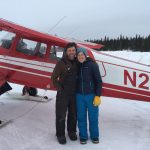
Wes Erb pauses for a photo with the author in Kaltag
“If someone likes it they do it for a lifetime,” Wes notes. Wes flew the trail as a tourist until 2003. During that time he saw IAF pilots flying down the trail with “other people putting

 Dropped dogs behind Lakefront Hotel
Dropped dogs behind Lakefront Hotel
The dogs are affectionate and loved to be petted.fuel in their tanks, staying in warm beds, not having to stay in cold tents or pay outrageous fuel prices.” After that realization, it was a natural move to join this elite group of pilots. Wes is a FedEx pilot by day but he admits the airlines can be a little dry with autopilot on for 99% of the flight. Flying for Iditarod gives him a chance to get out of high altitude jets, and fly his comparatively low and slow Cessna 180 with purpose. “I really want to thank the 75 mushers who get together every year and support my flying hours program,” he laughs. But for a guy who takes his vacation time to fly for Iditarod, that statement holds an element of truth. “Other people go to the beach; I go to Shaktoolik,” he smiles.
Small plane aviation has long been the connective tissue that binds together Alaskan life off the road system––and the IAF is an extension of that. Hard-working, safe, and immensely talented, the Iditarod couldn’t exist if it wasn’t for these dedicated pilots. They are the the lifeblood of the race who rise to this fluidic challenge with unmatched skill and professionalism. And
for that, the mushers, dogs, Insider team, and fans are endlessly grateful.
That's it until next year's Iditarod. Hope you enjoyed the posts! Comments are appreciated.
Soupy
Advertisement
Tot: 0.184s; Tpl: 0.013s; cc: 11; qc: 46; dbt: 0.0793s; 1; m:domysql w:travelblog (10.17.0.13); sld: 1;
; mem: 1.2mb



















Mary Beth Dubinsky
non-member comment
Fascinating Reading
Susan - your blog was well written, descriptive, informative, and enjoyable. I looked forward to reading it everyday to find out what was happening with the dogs, the mushers, the weather. and to see the spectacular scenary. It was a thoroughly wonderful blog. Thanks for writing and sharing it.